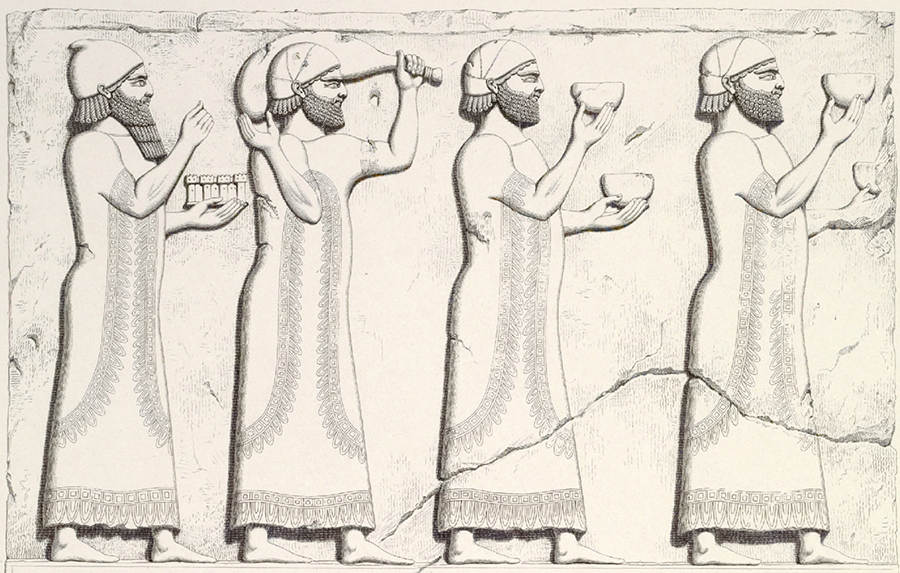Bianca Hand
The Relentless Pursuit of Difference in the Reliefs and Architecture at Sargon II’s Royal Palace at Khorsabad

Eugène Flandin, Line drawing of Non-Assyrian Tribute Procession Scene, Corridor 10, Royal Palace at Khorsabad, gypsum reliefs created during the reign of Sargon II (r. 721–705 BCE), from Monument de Ninive (Paris, 1849–1850). Photo: New York Public Library
My dissertation explores the subversive role of alterity by analyzing reliefs and architecture found in the royal palace of Sargon II (r. 721–705 BCE) at Khorsabad. The royal palace, located in present-day northern Iraq, is singular among Assyrian palaces in its limited history of use. Sargon II moved the capital of the Neo-Assyrian Empire from Nimrud to a new location at Khorsabad in 717 BCE. However, shortly after the palace was inaugurated in 706 BCE, Sargon was killed in battle and his palace was abandoned. His son Sennacherib (r. 705–681 BCE) moved the empire’s capital again, this time from Khorsabad to the ancient city of Nineveh. Thus, the palace was built, occupied, and abandoned within approximately 11 years. Given that most Neo-Assyrian palaces were occupied for generations, Khorsabad presents a rare opportunity to investigate a royal site that had input from only one king.
In contrast with previous studies, I propose that the presence of human (non-Assyrian peoples) and nonhuman (plants, animals, and architectural styles) “others” held the agency to subvert the royal relief program’s intended ideological message, making them especially powerful. I focus on three assemblages from Khorsabad’s Palace Terrace, which consisted of reception and residential suites. The first chapter explores the repetition of non-Assyrian figures in monumental tribute procession scenes and submission scenes—in which non-Assyrians are punished, presumably for rebellious behavior. Non-Assyrian figures carry bowls and city walls in each hand and full sacks over their shoulders in every tribute procession scene. While the objects may individually have a variety of interpretations, I argue that this assemblage represents the sustenance of the empire and, by extension, the strength of Sargon II’s kingship. The bowls represent abundance provided by the king through banqueting, city wall crowns represent territorial holdings brought into the empire, and bags over the shoulder represent sustenance for the empire in the form of agricultural tribute. Furthermore, I contend that the repetition of tribute procession and subjugation scenes in the Palace Terrace paradoxically reveals both an entrenched anxiety of rebellion and the contribution of non-Assyrian peoples in sustaining the empire.
The second chapter examines a depicted garden scene in the relief program of Room 7, a small room (50 m2) tucked in the center of three large reception suites in the Palace Terrace. I posit that its hunt scene is a commemorative relief program created to visually enumerate Sargon’s successes as king through the employment of foreignness—a foreignness that resides not in people, but in places and things. The landscape, architecture, and symbols of royal power depicted here are directly inspired by the recently conquered Syro-Anatolian and Levantine regions, which were locations of military activity during the early years of Sargon’s reign. The reliance on the foreignness of the landscape and architecture in Room 7 to convey meaning reveals a dependence on the other to visually construct Neo-Assyrian imperial identity.

Eugène Flandin, Line drawing of Sargon II and Soldiers Hunting in a Garden, Room 7, Royal Palace at Khorsabad, gypsum reliefs created during the reign of Sargon II (r. 721–705 BCE), from Monument de Ninive (Paris, 1849–1850). Photo: New York Public Library
The third chapter investigates architecture’s role in constructing otherness through a spatial and iconographic analysis of Monument X, a monument heavily influenced by Syro-Anatolian artistic and architectural practices. Adjacent to the Palace Terrace, Monument X is thus in conversation with the nearby Façade L, which depicted a procession scene of Assyrian figures carrying elaborate furniture thought to be treasure from Sargon’s campaigns in the Syro-Anatolian region. I argue that Façade L and Monument X complement each other as representations of “loot” brought into the palatial complex as a testament to Sargon’s military might. I conclude the dissertation by reiterating how depictions of the human and nonhuman other at Khorsabad were used to reify Neo-Assyrian imperial identity.
In the first year of my fellowship, I was able to visit every museum with a collection of objects from the royal palace at Khorsabad in both the United States and Europe. During these visits, I took object photos, measurements, and was invited to view storerooms, where I was able to examine objects that have provided new avenues of research. I was also able to connect with curators and colleagues who have provided valuable insights and opportunities to collaborate. In addition, my fellowship allowed me to visit the Karnak Temple in Egypt, where I was able to view and photograph reliefs that were included as a case study in the dissertation. I am indebted to the Center for supporting my research during the 2022–2024 academic years, which allowed me to conduct important research and provided the resources and time needed to complete my dissertation.
Johns Hopkins University
Twenty-Four-Month Ittleson Fellow, 2022–2024
Having successfully defended her dissertation, Bianca Hand will join the Classics Department at the University of California, Davis, as an assistant professor.
